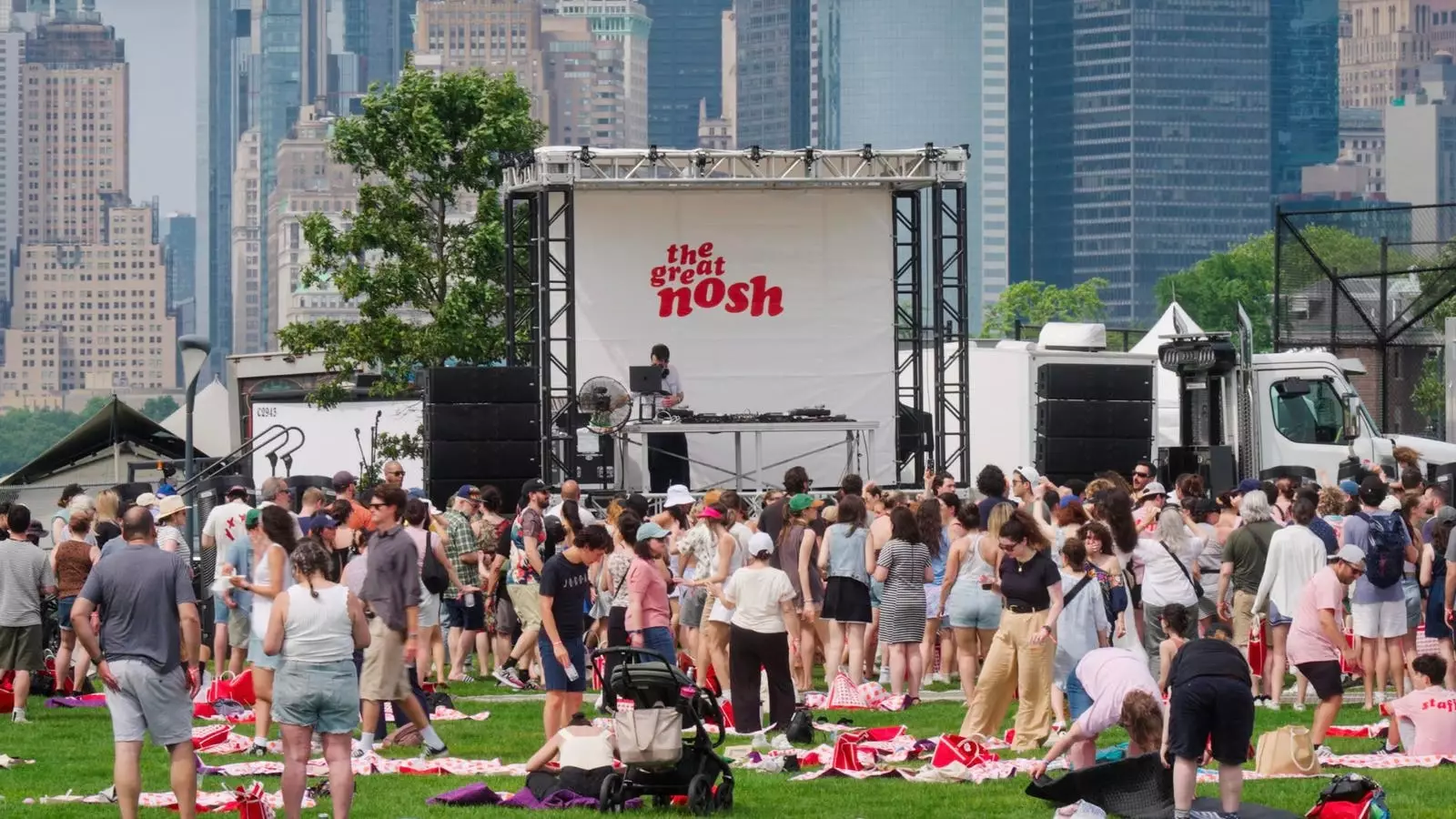In an era where division often dominates headlines, events that prioritize community cohesion and cultural celebration are all the more vital. The inaugural Great Nosh in New York City exemplifies how food can serve as a bridge, fostering joy, shared identity, and cross-cultural understanding. This festival, hosted on Governors Island, not only showcased an array of Jewish culinary traditions but also ignited a broader conversation about the evolving nature of cultural expression through cuisine. At its core, the event was less about the food itself and more about what food signifies—a vessel for storytelling, belonging, and resilience.
The city’s iconic skyline and the majestic Statue of Liberty provided an inspiring backdrop, turning a simple picnic into a powerful statement of cultural pride. Over 2,000 attendees ventured out to partake in this communal feast, revealing a collective hunger not just for delicious dishes but for meaningful connections. The organizers, led by Naama Shefi, envisioned the festival as a means to celebrate Jewish heritage in a way that is vibrant, inclusive, and forward-thinking. The event successfully highlighted how culinary traditions are not static but dynamic, continuously shaped by history, migration, and innovation.
This celebration of Jewish cuisine was much more than a gastronomic showcase; it was an affirmation of identity. The diverse menu reflected the multifaceted nature of Jewish food—spanning from traditional dishes to creative reinterpretations—demonstrating how cuisine is an evolving cultural language. It challenged stereotypes of monolithic Jewish food by emphasizing its global reach and seasonal flexibility. From schnitzel-and-chips to novel dishes like roti reubens, the event was a testament to how cultural boundaries in food can be crossed and blurred, leading to exciting new flavors and conversations.
Food as a Narrative of Resilience and Adaptation
The festival’s success was rooted in its emphasis on storytelling—each dish representing a chapter in a larger narrative. For example, the inclusion of Iraqi-Jewish Sabich and Korean-Jewish fusion dishes indicated a deliberate effort to highlight the diaspora’s diversity. These culinary mashups reinforce a vital truth: Jewish food is not confined to one region or tradition. Instead, it is a living, breathing tapestry woven from the journeys and adaptations of communities across the centuries.
The event also prioritized experiential learning, with cooking demonstrations and interactive stations that allowed attendees to explore the artistry behind the cuisine. The “Grandma’s Tent” offered insights into challah braiding, pickling, and hand-rolling couscous, effectively democratizing knowledge that is often passed secretively through generations. It created a space where the transmission of tradition was not merely about preserving recipes but about deepening understanding of culture’s resilience amid changing environments.
What makes the Great Nosh particularly compelling is its ability to make these stories accessible and engaging. For many, tasting a new dish or learning a traditional technique opens pathways to personal discovery—sparking curiosity about one’s roots or an appreciation for a culture different from their own. In a city as diverse as New York, such moments are powerful catalysts for empathy and solidarity. Food’s universal language acts as a subtle but potent force, forging bonds that transcend linguistic, religious, and cultural differences.
Innovation and Tradition Hand in Hand
One of the festival’s most noteworthy aspects was its commitment to celebrating both tradition and innovation simultaneously. Chefs and community members collaborated to produce inventive dishes that honored heritage while pushing culinary boundaries. For example, Zoe Kanan of Elbow Bread and Sunny Lee of Sunn’s created a vegetable-forward, Korean-inspired bialy and eggplant sandwich, fusing Jewish and Asian flavors in a way that felt fresh and thoughtful.
This spirit of culinary experimentation speaks to a broader cultural truth: traditions are living entities that thrive through adaptation and reinvention. The festival’s offerings demonstrated that respecting history does not mean stagnation; rather, it encourages a lively exchange of ideas that keeps tradition relevant for new generations. The creative reinterpretations challenge the misconception that cultural foods are static relics, instead positioning them as vibrant, evolving expressions that reflect contemporary identities and global influences.
The event also embodied the idea that food can serve as a form of activism—highlighting stories of migration, resilience, and identity. The festival’s emphasis on dialogue and discovery underscores a belief that shared meals can foster understanding in an increasingly polarized world. When people come together over a plate of food that carries stories of perseverance and adaptation, barriers start to crumble.
Looking Forward: A Model for Cultural Festivities
The significance of the Great Nosh extends beyond its initial success. It offers a blueprint for how cultural festivals can be both fun and meaningful, blending entertainment with education. The enthusiasm from attendees and the vibrant atmosphere suggest that this is a model worth replicating, not just within New York but across other major urban centers.
Naama Shefi’s vision of making the Great Nosh an annual event resonates with the broader goal of embedding cultural appreciation into the city’s annual rhythm. This event also aligns with a trend toward more intentional, community-focused festivals that prioritize storytelling and shared experiences over mere spectacle. By celebrating Jewish cuisine in a beautiful outdoor setting, the festival managed to carve out a space where cultural pride is tangible and contagious.
Moreover, the inclusion of high-profile artists like Mark Ronson exemplifies how the festival balances cultural roots with contemporary cultural icons, further broadening its appeal. Such collaborations can attract diverse audiences and foster a sense of unity that transcends specific cultural boundaries. As the event gains recognition, its potential to influence the cultural fabric of New York grows—inviting other communities to follow suit and celebrate their own heritage with equal vibrancy.
In essence, the Great Nosh embodies a hopeful future where food becomes a unifying force, inspiring new conversations and deeper understanding. It is a demonstration that when communities come together around shared traditions and innovative spirits, the result is a powerful celebration of resilience, diversity, and hope.


Leave a Reply